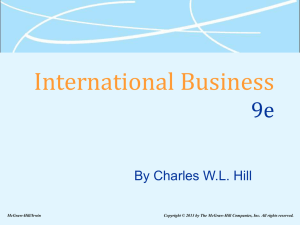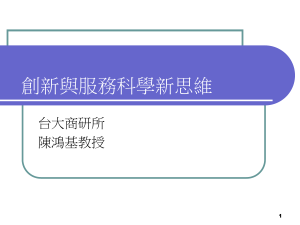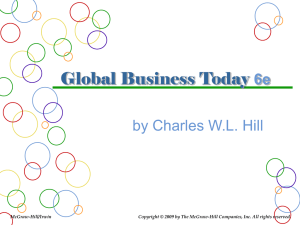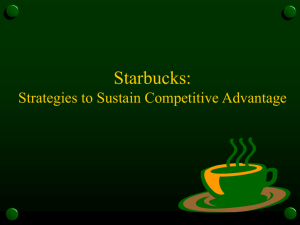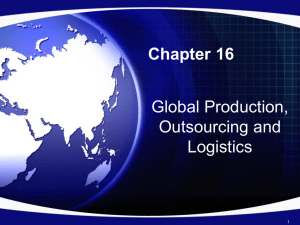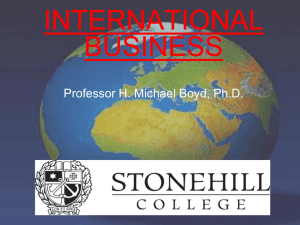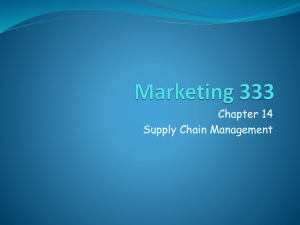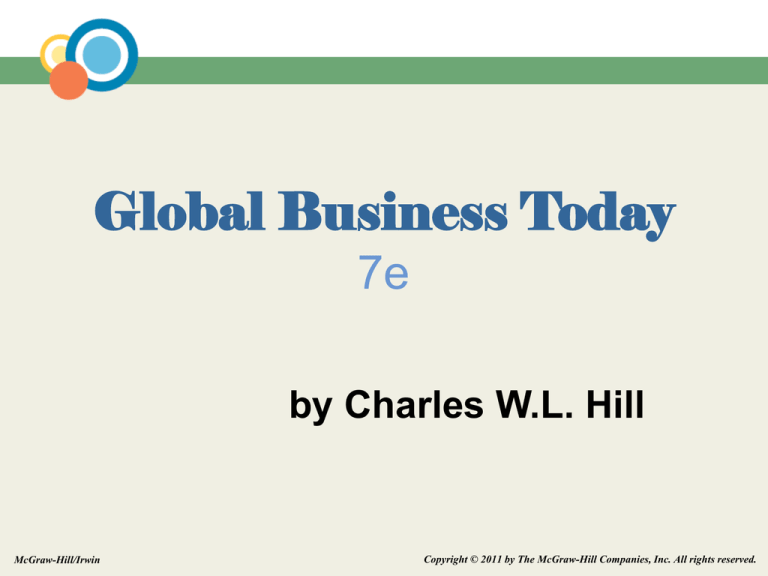
Global Business Today
7e
by Charles W.L. Hill
McGraw-Hill/Irwin
Copyright © 2011 by The McGraw-Hill Companies, Inc. All rights reserved.
Chapter 14
Global Production,
Outsourcing, and
Logistics
14-2
Introduction
In today’s global economy, firms must decide
where to locate productive activities
what the long-term strategic role of foreign production
sites should be
whether to own foreign production activities or
outsource those activities
how to manage a globally dispersed supply chain and
what the role of Internet-based information technology
should be in the management of global logistics
whether to manage global logistics or outsource
14-3
Strategy, Production, and Logistics
1.
2.
Question: How can production and logistics be
conducted internationally to
lower the costs of value creation
add value by better serving customer needs?
Answer:
Production - activities involved in creating a product
Logistics - the procurement and physical transmission
of material through the supply chain, from suppliers to
customers
14-4
Strategy, Production, and Logistics
The strategic objectives of the production and logistics
function are
to lower costs
to increase product quality by eliminating defective
products from both the supply chain and the
manufacturing process
These two objectives are interrelated
14-5
Strategy, Production, and Logistics
Better quality control helps firms reduce costs because
time is not wasted manufacturing poor quality
products that cannot be sold
re-work and scrap costs are lower
warranty costs and the time used too fix defective
products are lower
14-6
Strategy, Production, and Logistics
Question: What management tool is used to increase the
reliability of product offerings?
Answer:
The Six Sigma quality improvement program aims to
reduce defects, boost productivity, eliminate waste, and
cut costs throughout a company
Six Sigma is a direct descendant of total quality
management (TQM)
In addition, some countries have also promoted specific
quality guidelines like the European Union’s ISO 9000
standards
14-7
Strategy, Production, and Logistics
1.
2.
Two other objectives are important for international
companies
production and logistics functions must be able to
accommodate demands for local responsiveness
production and logistics must be able to respond
quickly to shifts in customer demand
14-8
Where to Produce
Question: Where should production activities be located?
Answer:
When deciding where to locate production facilities, firms
must consider
country factors
technological factors
product factors
14-9
Country Factors
Firms should locate manufacturing activities where
economic, political, and cultural conditions, including
relative factor costs, are most conducive to the
performance of that activity
Regulations affecting FDI and trade can significantly
affect the appropriateness of specific countries, as can
expectations about future exchange rate changes
14-10
Technological Factors
The type of technology used in manufacturing can affect
location decisions
Firms should consider
1. The level of fixed costs involved - if they are very high, it
could make sense for the firm to serve the world market
from a single location or from a very few locations
2. The minimum efficient scale of the technology - the
larger the minimum efficient scale (the level of output at
which most plant-level scale economies are exhausted)
of a plant, the more likely centralized production makes
sense
14-11
Technological Factors
3. The flexibility of the technology
The term flexible manufacturing technology or lean
production covers a range of manufacturing technologies
that are designed to:
reduce set up times for complex equipment
increase the utilization of individual machines through
better scheduling
improve quality control at all stages of the
manufacturing process
14-12
Technological Factors
Flexible manufacturing technologies enable firms to
produce a wide variety of end products at a unit cost that
traditionally would require mass production of a
standardized output
Mass customization - a firm may be able to customize its
product range to suit the needs of different customer
groups without bearing a cost penalty
14-13
Technological Factors
Flexible machine cells (grouping of various types of
machinery, a common materials handler, and a
centralized cell controller) are another common flexible
manufacturing technology
adopting flexible manufacturing technologies can help
the firm to customize products to meet the demands
of small customer groups in different national markets
So, firms can act like a local firm without bearing the
costs of establishing local manufacturing facilities
14-14
Technological Factors
Question: When does it make sense to concentrate
production at a few choice locations?
Answer:
Concentrated production makes sense when
fixed costs are substantial
the minimum efficient scale of production is high
flexible manufacturing technologies are available
Concentrated production does not make sense when
both fixed costs and the minimum efficient scale of
production are relatively low
appropriate flexible manufacturing technologies are
not available
14-15
Product Factors
Two product factors impact location decisions
1. The product's value-to-weight ratio
if the value-to-weight ratio is high, produce the
product in a single location and export it
if the value-to-weight ratio is low, manufacture the
product in multiple locations across the world
2. Whether the product serves universal needs
the need for local responsiveness is reduced for
products that do, which increases the attractiveness
of concentrated manufacturing
14-16
Locating Production Facilities
There are two basic strategies for locating
manufacturing facilities
1. Concentrating them in the optimal location and
serving the world market from there
2. Decentralizing them in various regional or national
locations that are close to major markets
14-17
Locating Production Facilities
Table 14.1: Location Strategy & Production
14-18
Strategic Role of Foreign Factories
Question: Does the rationale for establishing a foreign
production facility change?
Answer:
The strategic role of foreign factories and the strategic
advantage of a particular location can change over time
a factory initially established to make a standard
product to serve a local market, or to take advantage
of low cost inputs, can evolve into a facility with
advanced design capabilities
as governmental regulations change and/or countries
upgrade their factors of production the strategic
advantage of a particular location can change
14-19
Strategic Role of Foreign Factories
As the strategic role of a factory is upgraded and a firm
develops centers of excellence in different locations
worldwide, it supports the development of a transnational
strategy
a focus of a transnational strategy is global learning the idea that valuable knowledge does not reside just
in a firm’s domestic operations, it may also be found
in its foreign subsidiaries
So, managers should promote the idea that factories are
potential centers of excellence with strategic importance
to the firm
14-20
Make-or-Buy Decisions
Question: Should an international business make the
component parts to go into their final product or
outsource them?
Answer:
Make-or-buy decisions (decisions about whether to
perform a certain value creation activity in-house or
outsource it to another firm) are important to a firm’s
manufacturing strategy
14-21
The Advantages of Make
Making component parts in-house (vertical integration)
is attractive because it
1. is associated with lower costs
2. facilitates investments in highly specialized assets
3. protects proprietary technology
4. facilitates the scheduling of adjacent processes
14-22
The Advantages of Make
1. Lowering Costs - manufacture a part in-house if the firm
is more efficient at that production activity than any
other enterprise
2. Facilitating Specialized Investments - in-house
production makes sense when substantial investments
in specialized assets (assets whose value is
contingent upon a particular relationship persisting) are
required to manufacture a component
3. Protecting Proprietary Technology - in-house production
can make sense to maintain control over the
technology
4. Improving Scheduling - in-house production can make
planning, coordination, and scheduling of adjacent
processes easier
14-23
The Advantages of Buy
Buying component parts from independent suppliers
(outsourcing) is attractive because it
1. gives the firm greater flexibility
2. helps drive down the firm's cost structure
3. helps the firm to capture orders from international
customers
14-24
The Advantages of Buy
1. Strategic Flexibility
Outsourcing provides flexibility to switch orders
between suppliers as circumstances dictate
This ability is particularly important when changes in
exchange rates and trade barriers the attractiveness of
supply sources
14-25
The Advantages of Buy
2. Lower Costs
Firms that outsource can avoid
the challenges involved with coordinating and
controlling additional subunits
the lack of incentive associated with internal
suppliers
the difficulties with setting appropriate transfer
prices
3. Offsets
Outsourcing can help firms capture more orders from
suppliers’ countries
14-26
Trade-Offs
The benefits of manufacturing components in-house are
greatest when
highly specialized assets are involved
when vertical integration is necessary for protecting
proprietary technology
when the firm is more efficient than external suppliers
at performing a particular activity
14-27
Strategic Alliances with Suppliers
Question: Can strategic alliances with suppliers give
firms the benefits of vertical integration?
Answer:
Some firms have tried to use strategic alliances to
capture some of the benefits of vertical integration,
without having the associated organizational problems
However, in some cases, this backfires as firms find their
strategic flexibility limited by commitments to alliance
partners
14-28
Managing a Global Supply Chain
Question: Why is logistics important to the international
firm?
Answer:
Logistics - the activities necessary to get materials to a
manufacturing facility, through the manufacturing
process, and out through a distribution system to the end
user
complicated by distance, time, exchange rates, and
customs barriers, etc.
Efficient logistics can have a major impact upon a firm's
bottom line
14-29
The Role of Just-in-Time Inventory
Question: How can a just-in-time inventory process help
a firm?
Answer:
Just-in-time (JIT) economizes on inventory holding costs
by having materials arrive at a manufacturing plant just
in time to enter the production process, and not before
can result in major cost savings from reduced
warehousing and inventory holding costs
can help firms spot defective parts, take them out of
the manufacturing process, and boost product quality
14-30
Information Technology and the Internet
Question: What is the role of information technology in
materials management?
Answer:
Electronic data interchange (EDI)
facilitates the tracking of inputs
allows the firm to optimize its production schedule
allows the firm and its suppliers to communicate in
real time
eliminates the flow of paperwork between a firm and
its suppliers
14-31
Classroom Performance System
Decentralized production will be favored when
a) There are substantial differences in political economy
b) Fixed costs are high
c) The product’s value-to-weight ratio is high
d) Exchange rates are volatile
14-32
Classroom Performance System
Firms will prefer concentrated production when
a) Minimum efficient scale is high
b) Location externalities are not important
c) The product does not serve universal needs
d) There are few trade barriers
14-33
Classroom Performance System
Which of the following is not one of the key factors that
influence the decision of where to produce?
a) Country factors
b) Competitors factors
c) Technological factors
d) Product factors
14-34
Classroom Performance System
Buying from independent suppliers offers all of the
following advantages except
a) It gives the firm greater flexibility
b) It helps drive down the firm's cost structure
c) It protects proprietary property
d) It helps the firm to capture orders from international
customers
14-35

